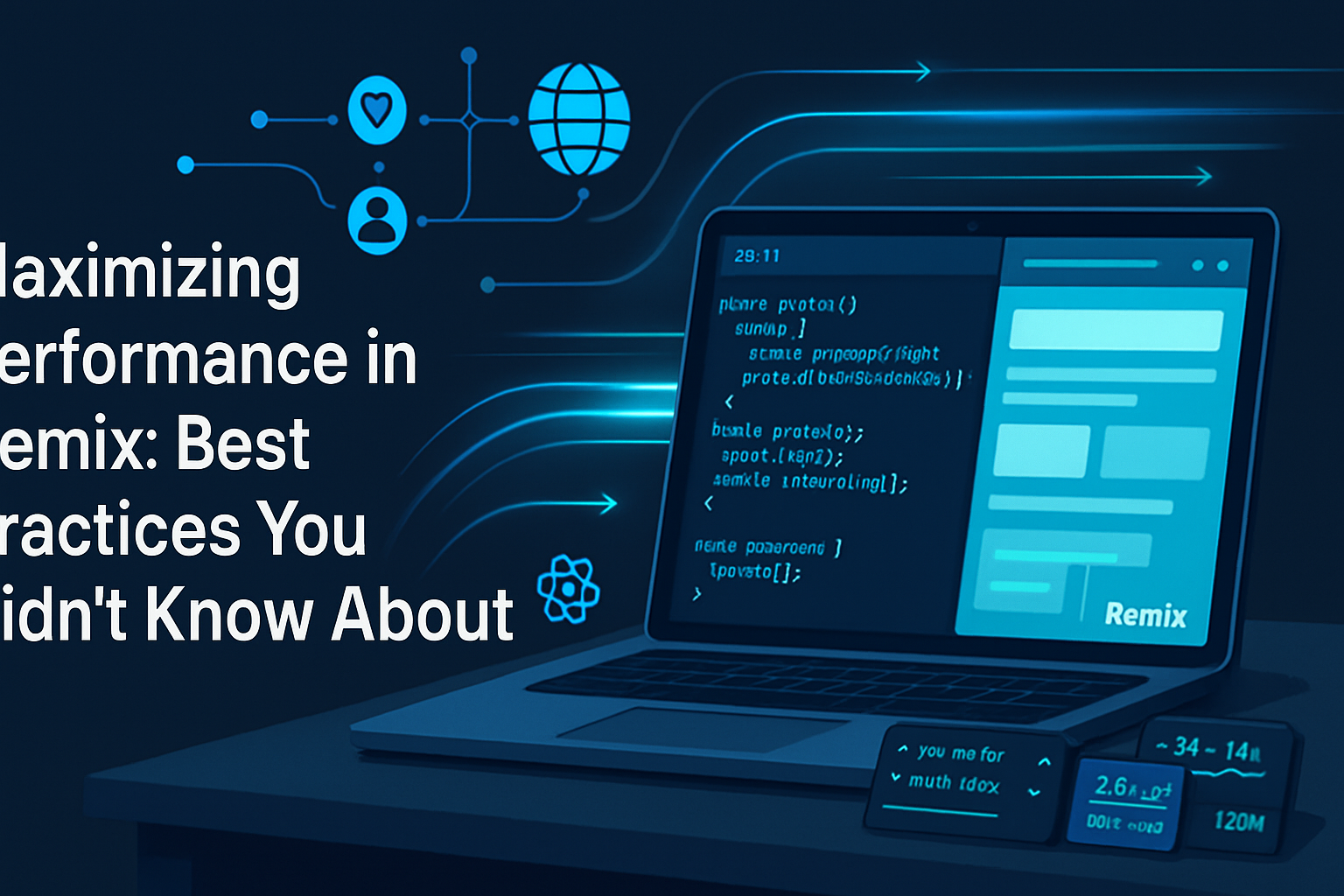· frameworks · 6 min read
Mastering Astro: 10 Tips for Lightning-Fast Websites
Get practical, actionable tips to make your Astro sites fast - from harnessing the islands architecture and partial hydration to optimizing images, bundling, and caching for real-world performance gains.

Why speed matters (and why Astro helps)
Astro is built around one principle: send less JavaScript to the browser. Its islands architecture and partial hydration model let you combine static HTML with interactive components that hydrate only when needed. That gives you a head start on performance - but you still need to apply best practices to get the most out of Astro.
This article walks through 10 practical, high-impact tips to make your Astro projects lightning-fast. Each tip contains why it matters, how to apply it in Astro, and short examples or config snippets you can copy.
Resources you’ll find useful:
- Official Astro docs: https://docs.astro.build/
- Islands / partial hydration concepts: https://docs.astro.build/en/core-concepts/partial-hydration/
- Vite (bundler used by Astro): https://vitejs.dev/
- Lighthouse and web performance guidance: https://web.dev/learn-performance/
Tip 1 - Embrace the Islands architecture and partial hydration
Why: Hydrating only the interactive parts of a page drastically reduces JavaScript shipped and executed.
How: Use Astro components for static parts and hydrate UI frameworks/components only where necessary with client directives: client:load, client:idle, client:visible, client:media, and client:only.
Example:
---
import Counter from '../components/Counter.jsx';
---
<section>
<!-- Static markup here -->
<Counter client:visible /> <!-- hydrate only when visible in viewport -->
</section>Notes:
client:visibleandclient:idleare great for deferring non-critical UI.client:onlytells Astro that the component must be loaded with a specific framework runtime.
Docs: https://docs.astro.build/en/core-concepts/partial-hydration/
Tip 2 - Choose the right rendering mode: SSG, SSR, or hybrid
Why: Pre-rendering removes runtime work from the client; SSR/edge rendering gives dynamic content without shipping heavy client logic.
How:
- Use static site generation (SSG) for pages that can be built at compile time.
- Use SSR when content is frequently changing or personalized.
- Consider incremental/regeneration approaches (or edge functions) to balance freshness and speed.
Example (Astro config hint):
// astro.config.mjs (concept)
export default {
output: 'server', // SSR
// or output: 'static' for SSG
};Notes:
- Static pages are fast to deliver via CDN (immutable caching). SSR can be fast if you use an edge adapter and caching.
- Use an adapter appropriate for your hosting (Netlify, Vercel, Cloudflare Workers, etc.).
Docs: https://docs.astro.build/
Tip 3 - Prefer framework-agnostic components and tiny UI libs
Why: Large framework bundles (React, Vue, Solid) increase JavaScript cost. Use plain HTML/CSS and small, focused components whenever possible.
How:
- Write interactive bits in small components or use web components.
- Reserve heavyweight frameworks for complex areas.
- If you must use a framework, scope it to islands and only hydrate where needed.
Pro tip: Solid and Preact are often lighter than full React; but pick by ergonomics and bundle size.
Tip 4 - Optimize images and media
Why: Images are often the largest assets on a page. Optimizing them reduces payload and speeds up rendering.
How:
- Use modern formats (AVIF, WebP) with appropriate fallbacks.
- Use responsive images (
<picture>/srcset) or an image integration plugin to generate resized variants. - Lazy-load offscreen images with
loading="lazy".
Example using native HTML:
<picture>
<source srcset="/images/photo.avif" type="image/avif" />
<source srcset="/images/photo.webp" type="image/webp" />
<img src="/images/photo.jpg" alt="..." loading="lazy" decoding="async" />
</picture>Astro has image integrations and guides - check the docs for the recommended plugin for your project and hosting: https://docs.astro.build/
Tip 5 - Split and defer JavaScript (use code-splitting and client directives)
Why: The less JS the browser must parse and execute before interaction, the quicker the page becomes interactive.
How:
- Use Astro client directives to limit hydration.
- Use dynamic imports inside components for large libraries and lazy-load them on interaction.
- Keep third-party scripts out of the critical path (defer, async, or load after hydration).
Example dynamic import:
// inside a client component
async function openEditor() {
const { Editor } = await import('./heavy-editor.js');
new Editor(...);
}Tip 6 - Use critical CSS and avoid shipping large CSS bundles
Why: Large CSS files can block rendering and increase transfer time.
How:
- Extract critical CSS for the above-the-fold content and inline it in the head.
- For the rest, load CSS asynchronously or use scoped component styles so unused rules are not shipped site-wide.
- Avoid global CSS libraries if you only use a few utilities.
Example: Astro components support scoped styles inside .astro files which can reduce CSS leakage.
Tip 7 - Leverage Vite and build-time optimizations
Why: Astro builds on Vite; tuning build settings reduces bundle size and improves dev and production performance.
How:
- Enable minification (default in production), treeshaking, and remove source maps in production.
- Use
optimizeDepsin Vite for known-heavy dependencies to pre-bundle them. - Keep dependencies up to date and remove unused packages.
Example vite hint (in astro.config or vite config):
// vite.config.js snippet
export default {
build: {
sourcemap: false,
minify: 'esbuild',
},
optimizeDeps: {
include: ['some-heavy-lib'],
},
};Docs: https://vitejs.dev/
Tip 8 - Cache smartly (CDN + Immutable caching + Cache-Control)
Why: Serving assets from a CDN and using long-lived caching drastically reduces load times for repeat visitors and global users.
How:
- Deploy static assets to a CDN.
- Use immutable caching (content-hashed filenames) with long TTLs for build artifacts.
- Configure cache-control for SSR responses appropriately (stale-while-revalidate can be powerful).
References:
- HTTP caching basics: https://developer.mozilla.org/en-US/docs/Web/HTTP/Caching
Tip 9 - Measure, profile, and focus on what matters
Why: Not all optimizations yield the same user-visible benefit. Measure real user metrics to prioritize.
How:
- Use Lighthouse, WebPageTest, and Real User Monitoring (RUM) to gather Core Web Vitals and bottlenecks.
- Profile JavaScript execution to find long tasks.
- Track metrics before and after changes to verify wins.
Resources:
- Web performance learning path: https://web.dev/learn-performance/
Tip 10 - Optimize third-party scripts and fonts
Why: Third-party widgets, analytics, and fonts are frequent culprits for jank and larger loads.
How:
- Load non-critical third-party scripts with
async,defer, or inject them after interaction. - Use font-display: swap and subset fonts. Consider hosting fonts on your CDN and preloading the most-used ones.
- Prefer privacy-focused, lightweight analytics (or sample/aggregate) to avoid heavy libraries.
Example preload font in head:
<link
rel="preload"
href="/fonts/inter-400.woff2"
as="font"
type="font/woff2"
crossorigin
/>Quick Astro Performance Checklist
- Use islands/partial hydration (client directives) - hydrate only what you need.
- Prefer SSG where feasible; use SSR only when necessary.
- Optimize and lazy-load images (use AVIF/WebP and responsive images).
- Defer third-party scripts and large libs; code-split heavy UI.
- Inline critical CSS and scope component styles.
- Configure Vite/build for production (minify, no dev sourcemaps).
- Deploy behind a CDN with immutable caching for assets.
- Measure using Lighthouse/RUM and prioritize based on metrics.
- Optimize fonts (preload, subset, font-display: swap).
- Use an appropriate Astro adapter for your deployment target.
Closing notes
Astro gives you a powerful baseline for fast sites by minimizing client JavaScript and making hydration explicit. The biggest gains come from combining Astro’s architecture (islands + partial hydration) with solid engineering practices: optimize images, split JS, cache aggressively, and measure results. Start by measuring your current performance, apply a few of these tips, and iterate - you’ll see real-world improvements for your users.
Further reading and the official docs are at https://docs.astro.build/.


